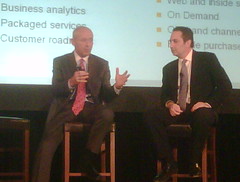Event Report: 2009 SAP Influencer Summit - SAP Must Put Strategy To Execution In Order To Prove Clarity Of Vision




(Photos by R Wang & Insider Associates, LLC. Copyright © 2009 All rights reserved.)
Re-innovation Now At The Heart Of SAP's Focus And Strategy
SAP has faced a rough two years. From the continuing market pressure on new license revenue, false-start launch of Business By Design (ByD), management restructuring, and issues with user groups and Enterprise Support, one could kindly say its been a brutal period. Looking forward to a fresh start in 2010, senior executives and key personnel have been hard at work "re-innovating" SAP at both the product and marketing level. As intended, many of the 275 analysts, bloggers, customers, influencers, and media attendees of this year's SAP Influencer Summit left Boston with the perception that the company is in the midst of such transition. However, the clarity of that message and the perception of innovation depended on the topic at hand.
Five key themes drove most formal and informal conversations throughout the event:
- SAP continues to be innovative. John Schwarz, SAP Executive Board Member, keynoted on stage that " We are not your grandmother's SAP" and addressed SAP's aspiration to become more customer focused and innovative. Jim Hagemann Snabe, Executive Board Member in charge of Business Technology and Solutions, touted the product vision. Vishal Sikka, SAP's Chief Technology Officer (CTO) focused his conversation on Timeless Software and SAP's cloud orientation. He emphasized the size of future data volumes and the case for why In-Memory applications would provide the access speed and key meta-data required to draw inference for usage in business intelligence and analytics. Meanwhile, John Wookey, who leads SAP's OnDemand for Large Enterprise effort commented on the Cloud by stating, "SAP sees On-Demand as the next major change in computing models and we're very serious about on-demand. Innovation in on-demand (deployment options) is still largely in front of us."
Point of view (POV): SAP's working hard to highlight its innovations. With €1.6B spent a year in R&D, innovation exists in SAP Labs but management and tribal politics often keep good ideas from becoming productized. Users will need to work closely with SAP to identify needs and requirements and help SAP prioritize what should go to market. Cloud strategy remains hazy in specifics. In-memory approach will benefit customers but will take time to develop across all products. OnDemand for Large Enterprises could slow in-roads by pure-play SaaS vendors.
- Business analytics and intelligence play a key role in the platform. Executive Vice-President and General Manager, Marge Breya spent much time talking about SAP's support for heterogeneous data sources. As the BOBJ assets integrate into NetWeaver, her emphasis would be to deliver information across new platforms and use cases. Project Kona for business intelligence (BI) OnDemand in mobility would play a key role in changing how users access SAP information.
POV: Customers need better information in order to make key decisions. BI plays a significant role in delivering such value to customers and the Business Objects acquisition provides the enabler. However, SAP users still find data quality and data governance to be a key hole in the SAP information strategy. SAP will need to address the different approaches in master data management (MDM) and help customers understand which set of tools should be applied in each customer scenario.
- Future growth rests with success in small and medium enterprises. With most of the large enterprise saturated with packaged apps such as ERP, SAP's future growth rests on its ability to move down market. The SME team led by Hans-Peter Klaey shared progress on their 3-prong product strategy with Business One (B1), Business All in One (BAiO), and Business by Design (ByD). B1 continues to gain traction in the small end of the market and SAP has published a product road map well past 2014. The key issues remain the future of ByD and how SAP plans to scale growth.
POV: With hopes of getting ByD to scale, Feature Pack 2.5 promises to bring in-memory analytics, multi-tenant support, mobile device enablement, Microsoft Silverlight UI's, and a software development kit based on Microsoft Visual Studio. Scaling remains a big issue but now becomes technically feasible. Conversations with Rainer Zinow, Senior Vice President for SME Strategic Solution Management; Christoph Behrendt, Senior Vice President for Midsize Enterprises; Peter Lorenz, Senior Vice President, SME Solutions; Jeff Stiles, Senior Vice President for SME Marketing; and others, highlight the advanced progression in SAP's SME thinking. Early indications show promise that they will eventually approach the market with the right scaling, go to market plan, and cost structure to succeed. Movement towards more Microsoft technologies will help attract B1 partners, especially many at Sage who may be disgruntled but technically competent and customer service oriented. - Sustainability is more than a trend. Building on its Clear Standards acquisition, SAP continues to drive mind share in the field of sustainability tracking. Key topics include the usual suspects of carbon emissions, energy consumption, and compliance. The Business Objects Sustainability Performance Management offering showcased new areas such as product and workplace safety. Its recent Sustainability Report highlights how SAP uses its own software to achieve its corporate objectives. Sustainability shows growth as a board-level topic and issue of concern.
POV: More than just buzzwords, SAP's making a considerable investment in sustainability. By providing the right templates and KPI's for external reporting, SAP will transform social responsibility aspirations to reality for its interested customers. Peter Graf, SAP's Chief Sustainability Officer, has harnessed the do-good spirit of SAP's employees in building out SAP's offerings. Expect sustainability to be a key area in repairing SAP's current image. Conversations with customers indicate that sustainability may not be a primary reason to choose SAP today, but SAP's investment and commitment in this arena brings SAP into conversations with key business leaders and has led to deal flow. However, long term success in sustainability will require good master data management (MDM) and SAP must rapidly address this issue or face the prospect of false promises. - Partners and ecosystems matter. The partner ecosystem team continues to evolve and innovate with new programs that not only attract new partners, but also improve partner readiness. SAP currently works with 7000 go to market partners and the SAP Developer Network boasts 2.5M developers. Efforts such as the SAP Mentor program, SAP Partner Edge, SAP EcoHub, and SAP Community Network by Zia Yusuf and his successor, Singh Mecker, Senior Vice President of GEPG provide proof points of progress and success.
POV: The EcoHub provides customers, partners, suppliers, and internal employees with a collaboration point for subject matter experts, trouble shooting, and fostering community. SAP's partner ecosystem remains its strongest asset. In order to capitalize on their success, SAP must make the necessary investment in revamping the technology platforms partners build on. Should they fail in providing an easier platform, they will lose traction and adoption. Partner-led innovation will move to easier platforms to work with and business models that sustain profitability.
SAP's Efforts In Strategy To Execution Rates A "B-" For Now
Applying a quick Vendor Scorecard grading system, here is a subjective evaluation of SAP's 2009 efforts to date*:
- Leadership: "B-". Leo Apotheker and Bill McDermott failed to show up again at a key event. While this was Q4 and a tough quarter, customer and influencer perceptions remain low on Leo given his decision to push Enterprise Support and the lack of clarity into his vision and approach to date. To be fair, he has faced a tough hurdle in cleaning up mistakes from his predecessor, Henning Kagermann, and has had to streamline research and development as well as a sprawling bureaucracy. The good news - their absence highlighted the emerging bench strength of talent within SAP. This brought some confidence to many in attendance that SAP may have the right stuff to emerge. The bad news - rumors abound on when a successor (Co-CEO) would be announced as Leo's contract expires in June 2010.
- Product strategy: "B+". Sustainability, integration of Business Objects componentry, Enhancement Packages (EhP), and In-Memory apps receive praise. Meanwhile, adoption of ERP 6.0, remains slow. SAP cites 50% of all product instances on to ERP 6.0. However, actual customer counts may be less given the fact some customers have 25 to 50 instances of SAP. Only 3500 customers have used Enhancement Packages. Customers remain confused on the value of Business Suite 7, upset with paying twice for BW and Business Objects, and disappointed with SAP's slow approach to SaaS and onDemand. Successful relaunch of ByD in 2010 may help SAP gain traction. Customers await delivery on OnDemand offerings for Large Enterprise but can not wait much longer. InMemory Apps planned for 2014 must be delivered on-time to compete with Oracle's Fusion Apps. Despite the lack of clarity, SAP still has the richest set of business functions and ability to handle the greatest set of complex scenarios.
- Technology strategy: "C+". Middleware strategy remains murky at best. SAP should revamp NetWeaver or junk it. NetWeaver is to Blackberry as Salesforce.com's Force.com is to iPhone. It's so much easier to build apps on Force.com and iPhone than it is for SAP's NetWeaver and RIM's Blackberry. The decision to emphasize the NetWeaver ABAP stack over the NetWeaver Java stack will leave customers and partners confused despite how much more efficient it is to build on ABAP. In addition, the lack of good business process orchestration at both run time and design time remains a critical hole for investment and gives vendors such as IBM and Cordys opportunities to sit on-top of SAP apps. Mobile strategy at first seems less emphasized with the rare mention of native apps development on Blackberry and other platforms. Nevertheless, SAP's decision to leave mobile platform integration of Blackberry and others at the NetWeaver Mobile layer may prove to be the most efficient and effective approach. The move to in-Memory will help with future development, yet customers lack confidence in SAP's execution of the Timeless Software argument, despite its best intentions. It appears that SAP will have 2 OnDemand strategies. Lighter applications will be built on Java. More complex applications to be built on the OnDemand stack.
- Go to market strategy: "B+". "Best Run Now" packages deserve credit for bringing business value from analytics into core business processes. Slow adoption can be blamed on a sales teams who treated this as a new license sales opportunity instead of an entry point to showcase SAP value. Customers could see the sales reps salivating with each interaction for a new sale. Kudos go to SAP for finally admitting failure with ByD and working hard with customers and partners to revamp efforts. SAP's marketing team remains the most innovative and effective. Just wait till they get products that keep up with their marketing.
- Innovation agenda: "B-". SAP's making in-roads in the right areas. Project Constellation, integration with Google Wave, and social networking investments highlight some movement towards disruptive technologies. SAP must rapidly productize innovations from the SAP Imagineering team, worldwide SAP Labs, SAP COIL, and its consulting partners. SAP needs to tap into its ecosystem and bring out innovation.
- Service and support: "C+". Customers continue to self-support and question SAP's value. As more customers consider third party maintenance, SAP will have to fight harder to demonstrate value. On the positive front, SAP's Value Academy shows promise in helping customers optimize their SAP investments. Initial discussions with Chakib Bhoudary, SAP's Chief Value Officer, indicate the deep level of experience and data provided. Customers will want to see how to access these services with minimal investment or redirected maintenance investment.
- Customer satisfaction: "C+". Conversations with over 400 customers in 2009 highlight severe disappointment with their SAP relationship. Sales reps compensated on net new license sales no longer invest in guiding customers through the SAP offerings. Customers fail to adopt due to lack of knowledge. They no longer trust their SAP sales reps nor do they have high confidence in the system integrators to guide them to the most cost effective solution. SAP sales reps need to understand their products better. Those customers who are able to make a trip to Walldorf (WDF), find solace that the old SAP still exists with passionate and dedicated engineers. Customers appreciate the honesty in WDF about what can or can not be accomplished with SAP. However, this is not a scalable model for SAP. SAP will need to retrain and reincentivize its sales reps. Applying social enterprise methods to the great SAP ecosystem may prove to be fruitful in scaling out more personalized approaches.
- Execution to date: "C-". Failures abound in execution in Enterprise Support, NetWeaver adoption, ByD roll-out, Duet usage, and Solution Manager capabilities. SAP's current state is similar to Microsoft's prior to the launch of Bing and Windows 7. SAP needs a success story soon to not only raise morale, but also gain customer confidence in its ability to deliver. Jim Hagemann Snabe's efforts at streamlining and centralizing development provides at least a positive indicator.
- Partner ecosystem: "A". The team has built one of the best technology partner ecosystems in the market. The emphasis on community outreach, influencer participation, and investment in a partner's success continues to be a differentiator. SAP's ecosystem strategy should be credited with saving SAP during this round of crisis. A move towards Microsoft technologies such as SharePoint and Silverlight will help in gaining developer traction and adoption. Fix NetWeaver and the ecosystem will have a tool they can innovate from.
- Overall reputation: "B". SAP carries significant brand presence in emerging markets and the SME space. Many companies equate ownership of SAP as a sign of success in their markets. Yet, existing customers have soured on the brand and continue to wonder when SAP will innovate in their requirements and not be distracted by other pursuits. In general, SAP still carries considerable brand equity which will buy it time as it reinnovates.
* A=4.0, A-=3.7., B+=3.3, B=3.0, B-=2.7, C+=2.3, C=2.0, C-=1.7, D+=1.3, D=1.0, D-=0.7, F=0
The Bottom Line - SAP's Turning The Corner
Credit must be given to SAP for charting a new course. A shift in the management philosophy and product direction will take years to realize, however, its not too late for change. SAP must remember its roots and become more German and less American. The renewed focus must put customer requests and priorities ahead of SAP's bureaucracy. The emphasis must focus on the relationship. When that reemerges in how SAP works with customers, partners, influencers, and its own employees, SAP will be back in good graces. In the meantime, it's time to get to work and deliver. Oracle's Fusions Apps are coming soon and competitors such as IBM, Microsoft, Epicor, IFS, and SalesForce.com will not relent.
Your POV.
If you get a chance, let us know:
- Which SAP products do you use?
- What do you think about the progress with SAP?
- Are you considering alternatives to SAP?
- Do you feel SAP is innovating fast, ok, or slow enough?
- What do you think of SAP's new reinnovation strategy?
Feel free to post your comments here or send me an email at rwang0 at gmail dot com or r at softwareinsider dot org.
Other related links and good resources
SPECIAL: Video clips from the SAP Influencer Summit from SAP
20091211 ZDNet Software & Services Safari - Brian Sommer "SAP Business ByDesign Update: Multi-tenancy, In-Core Memory DB and More"
20091211 MichaelFauscette.com - Michael Fauscette "SAP Coming Out From the Clouds"
20091210 ZDNet Collaboration 2.0 - Oliver Marks "SAP: The clear path forward for the supertanker..."
20091209 ZDNet IT Project Failures - Michael Krigsman "Is on-premise ERP obsolete?"
20091209 ZDNet Social CRM: The Conversation - Paul Greenberg "SAP Business Influencers Summit: A Clear Path Forward?"
20091209 Spend Matters - Jason Busch "SAP Influencer Summit, Dispatch 1: On-Demand Differentiation and Vision"
20091209 Monkchips - James Governor " SAP: Out with the Old, Shrugging off the Tag"
20091209 Merv's Market Strategy For IT Suppliers - Merv Adrian "SAP Promises Acceleration on a "Clear Path" - Will it Be Enough?"
20091209 CIO Reinvented Blog - Prasanth Rai "Interesting Data/Statistics About SAP...(Influencer Summit)"
20091209 DealArchitect - Vinnie Mirchandani "SAP and The Boston Park Plaza"
20091209 Cloud Avenue - Zoli Erdos "Twitter in the Enterprise - Round 56745327"
20091208 ZDNet IT Project Failures - Michael Krigsman "SAP Influencer Summit: First Impressions"
Copyright © 2009 R Wang and Insider Associates, LLC. All rights reserved.
 R "Ray" Wang
R "Ray" Wang R "Ray" Wang
R "Ray" Wang